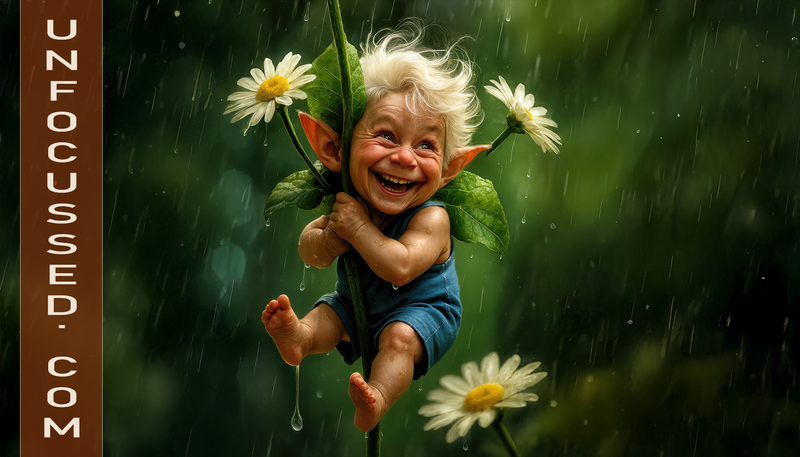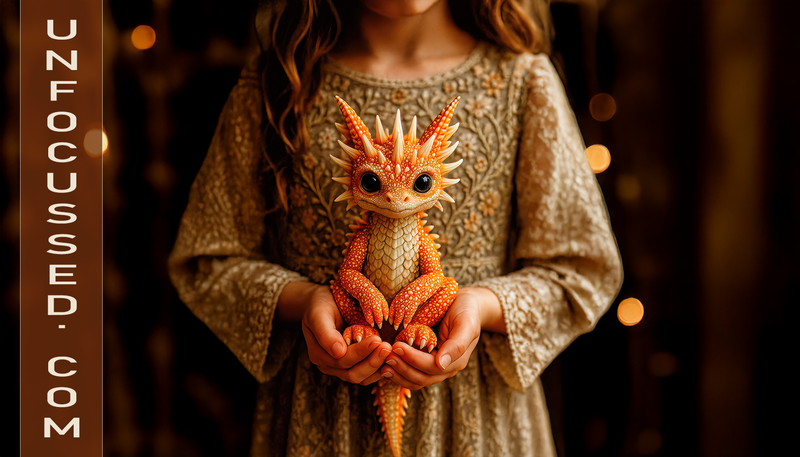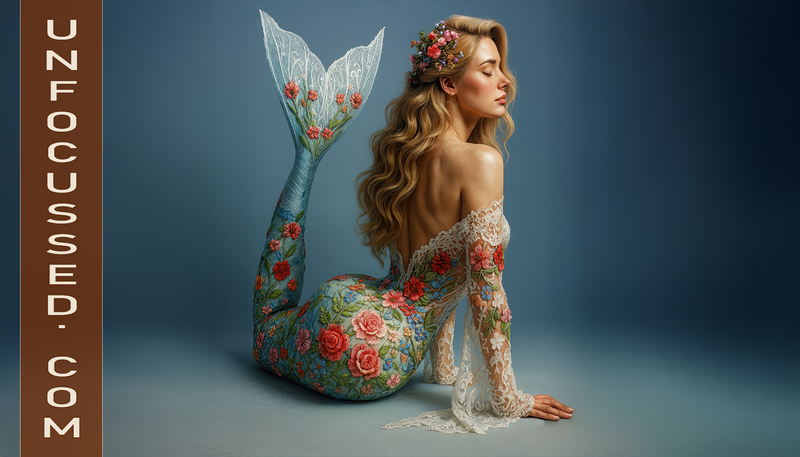Cuentos capturados – por Bill Tiepelman
Fairytales in the Making
The Wand Chooses the Whisker
The evening arrived the way good stories do: with a thunk. Specifically, the thunk of an ancient spellbook landing on an even older wooden floor, followed by a puff of pale glitter that smelled faintly of cinnamon toast and improbable ideas. Across from the book sat a girl in a pink lace dress and a wizard hat bravely decorated with stars that looked like they’d auditioned for the moon and gotten a call-back. She held a wand that was definitely not a toy, if only because toys rarely hum in three keys at once or negotiate overtime for miracles. Beside the book, perched on a small stool with the solemn dignity of a tiny emperor, was yours truly—Marzipan, an adorably ferocious white kitten with junior dragon credentials: soft wings, a starter tail, and the sort of eyes that make adults say, “We can’t possibly take that home,” while already googling “cat-safe enchanted litter.”
You might be thinking: “A kitten with wings? That’s a phase.” First, rude. Second, phases are for the moon; I’m a lifestyle. I’m also the narrator because the spellbook insists on doing only union-approved exposition and the wand refuses to monologue without stunt pay. Besides, you want the whisker-level view. Trust me. I’m close to the ground, but professionally lofty. This is a tale about magic and wonder, the power of imagination, and the surprisingly complex logistics of fitting a dragon personality into a housecat chassis. (We’ll get to doorframes. And curtains. RIP curtains.)
The girl—her name is Wren, and yes, like the bird, which is confusing for a cat and terrible for my therapist—leaned closer, her hat brim forming a rosy eclipse. “Ready?” she whispered, and the wand brightened to a star-core spark. Sparks are like opinions: harmless in moderation, catastrophic near parchment. The spellbook fluttered in alarm until Wren patted its margin like a skittish horse. Pages calmed. Letters rearranged themselves, lining up into neat little ranks like toy soldiers who have just been told they’re going to war against dust.
Here’s the first rule of responsible enchantment (and excellent wall décor): Frame the moment before it frames you. Wren did exactly that. She shifted the book a finger-width, angled the stool, and squared the wand so the light fell in a golden triangle—girl, book, beast—like a perfectly staged fantasy scene artwork. It wasn’t vanity; it was geometry. Magic is picky. If the composition tilts wrong, the spell comes out as lukewarm tea or, worse, paperwork. We were here for wow, not warranty forms.
“By the glitter of small brave things,” Wren intoned, “by whisker and wing and a really good nap, reveal the dragon you want to be.” She looked at me, and the look said everything: I know what the world sees; let’s show them what it can’t yet imagine. The star at her wand-tip pulsed. A soft aurora spilled into the room, drifting over floorboards that had seen more birthdays than the moon knows how to count. The air smelled like comet sugar and warm library. Dust motes signed NDAs and turned into constellations. Above my little emperor head, a dragon-outline took shape—luminous, playful, slightly dramatic. (We share traits.)
I won’t exaggerate. Okay, I will, but only where necessary. The light kissed my ears. It threaded my fur like spun silver. It ran its curious fingers along my rookery of dreams, tasting the places where kitten ends and dragon begins. I felt bigger—not taller, but roomier, as if my ribcage were a cathedral for bell-notes I hadn’t learned to ring. The wings—usually decorative unless someone opens tuna—stretched with a silky shiver. The tail (still on probation) traced a tidy question mark in the air, which is appropriate, because questions are how the universe preheats.
“Marzipan,” Wren said, “this is only practice.” Her voice had the authority of a lighthouse and the softness of a bedtime promise. Adults underestimate bedtime promises. They’re tiny contracts with amazement. She guided the wand in a slow circle. The star sang a note that made the book’s leather sigh and the room’s shadows scoot politely aside. The shimmering dragon—my possibly-future, possibly-now—tilted its head as if to say, Nice to meet me.
I chirped. (Dragons roar; kittens chirp. We’re working on it.) The sound threaded through the spell, and the aurora brightened. Somewhere, a curtain surrendered. My wings caught a draft of not-quite-wind, the way hope sometimes inflates your chest while your feet are still figuring out the memo. For a breathless second, I left the stool by the scientific distance of three crumbs and a rumor. Wren gasped. I landed—gracefully if you’re generous, hilariously if you’re sentient—and pretended that had been the plan. Sassy dignity is ninety percent pretending it was the plan.
Listen, dear reader, collector, daydreaming adult who knows that a home needs at least one piece of whimsical fantasy art to keep the dust honest: there’s a reason we start with practice. Magic is a muscle, and imagination is the gym membership you actually use. Tonight, we were lifting small wonders. Tomorrow, we might bench-press the moon (ethically). For now, the goal was simple: hold the pose, make the light, and let the moment become a photograph the heart doesn’t forget, the kind you frame over a reading chair and point to when guests ask, “Is that a kitten with dragon wings?” and you say, “Obviously,” as if obviousness were a type of courage.
The star dimmed to a smolder. The dragon-outline hovered like a possibility deciding whether to land. Wren smiled—mischief with a bow on it. “Again?” she asked. The spellbook rustled its pages into applause. I adjusted my tail, lifted my whiskers, and summoned my best legend-in-training face. The wand lifted. The room held its breath. And somewhere beyond the rafters, the universe leaned in like a friend with tea saying, “Tell me everything.”
The Curtain Conspiracy
You know how some nights feel like the universe has RSVP’d early and showed up with hors d'oeuvres made of starlight? This was one of those. The dragon-outline above my head shimmered like a soap bubble that had majored in theatrics. Its wings stretched wider, its glow reflected in Wren’s big curious eyes, and for the record, I looked spectacular. Not “cute kitten with a gimmick” spectacular, but “if Da Vinci had painted a housecat after three glasses of enchanted wine” spectacular. Naturally, nobody took a picture. Humans. Always trusting memory like it’s not leaky as a colander in a rainstorm.
“Stay still,” Wren whispered, as if I were a nervous ballerina. Which was adorable, because kittens and ballerinas share exactly one thing: the inability to resist twirling when provoked. My whiskers tingled with the vibration of her spell. The wand hummed like it had downloaded a suspiciously large software update. The spellbook’s pages quivered, their letters leaning out like nosy neighbors over the hedge. This was art in the making—not polished, not framed, but wild, alive, and un-housebroken.
Then came the curtains. Curtains, dear reader, are the sworn enemies of magic. They hang there, smug, pretending to frame windows when their real hobby is strangling fledgling miracles. As my dragon-shadow flexed its magnificent phantom wings, one little arc of energy snagged the hem of a paisley drape and—whoosh—ignited the entire panel in a shimmer that smelled like bubblegum and embarrassment. It didn’t burn. Oh no, nothing so simple. It started dancing. Yes, dancing. A two-step shimmy, complete with sways and the occasional pirouette.
“Marzipan!” Wren hissed. Which was unfair, because frankly it wasn’t my fault the curtains lacked professional discipline. But fine. I puffed myself up, wings out, tail curled like a punctuation mark, and chirped a single commanding note. The aurora above me pulsed in agreement. The curtains froze mid-shimmy, blushing an apologetic shade of rose. Then they collapsed into ordinary fabric again, flopping like teenagers caught sneaking back past curfew.
“Better,” Wren said, lowering her wand slightly. Her grin betrayed her tone: she was delighted. She always was when magic misbehaved, because that’s when the story got good. If you’ve ever been an adult trying to explain why your living room contains charred drapery and a kitten who looks suspiciously like he’s hiding a flamethrower in his fur, you understand: these are the anecdotes that build reputations.
Let’s pause here and acknowledge something important. Magic is 40% ritual, 30% imagination, 20% chaos, and 10% snacks. Without snacks, things get feral. Tonight’s snack of choice was a saucer of milk balanced on a nearby shelf, a decoy offered to distract me should the spell grow too interesting. Rookie mistake. Milk is a beverage; chaos is a calling.
Wren turned a page in the spellbook. The parchment whispered. The letters rearranged themselves again, but this time, instead of tidy little ranks, they became doodles—spirals, stars, one rude caricature of me that made my ears look like satellite dishes. “Don’t look at that,” I mewed. She ignored me, tracing the spirals with her finger. The wand glowed brighter, matching her focus. Imagination feeding magic feeding imagination. A feedback loop of whimsy. Dangerous. Delicious.
The dragon-outline thickened. No longer a suggestion, but a half-sketched reality. Its scales glittered like someone spilled diamonds over midnight. Its tail brushed the rafters, leaving trails of neon-green afterlight. Its eyes blinked open, two lanterns of golden curiosity. And the funniest thing? It looked exactly like me—if I’d been upgraded to “Boss Level.” Same smug whisker tilt. Same sly tail flick. Same general aura of “Yes, I deserve fan mail.”
Wren squealed softly. She clapped her hands, which nearly broke the spell (never clap near active magic, folks, unless you want applause from dimensions you didn’t invite). “It’s working!” she said. Her hat slipped sideways. The dragon-shadow cocked its head like a critic evaluating the performance. Then it winked at me. Yes, winked. Nothing chills a kitten’s blood quite like being winked at by your hypothetical glow-in-the-dark doppelgänger.
I bolted. Not far—just across the floor to the safety of an overturned shoebox. My wings flared, my tail lashed, and my pride leaked out like glitter from a party bag. Wren giggled. “Don’t be shy,” she said. Easy for her; her doppelgänger wasn’t about to unionize and demand equal cuddles.
The spellbook flapped impatiently, pages flickering like an angry bird. Its margins scribbled notes to itself: stabilize resonance, feed imagination, don’t let curtains unionize again. Wren nodded sagely, as though she’d understood any of that. Then she raised the wand high, the star at its tip swelling to a miniature sun. Shadows scattered to the corners. Dust motes rearranged into a polite audience. The room became a stage. We were the players. And the story—our story—was stretching its wings.
I crept forward again, cautiously. The dragon-shadow lowered its glowing head, meeting me eye to eye. We studied each other. Both smug. Both curious. Both knowing that someday, one of us would outgrow the other. Then, in a moment that made the air quiver like a plucked harp string, the dragon’s muzzle touched my forehead. Not physically, but in a shimmer that tingled like carbonated stars. A rush flooded me—warmth, vastness, mischief on an elemental scale. Suddenly, I didn’t just imagine being a dragon. I remembered it. Past lives, future selves, impossible stories, all stacked like teacups balanced by fate’s drunk uncle.
Wren gasped. “Did you see that?” she whispered to no one in particular. The wand pulsed, echoing the bond. The spellbook scribbled furiously, quills squeaking. The curtains wisely stayed out of it this time. The dragon-shadow pulled back, leaving me dizzy with wonder and hungry for fish. (Magic always makes you crave fish. Don’t ask why.)
And that’s how it began: not with fire or fury, but with curtains that couldn’t dance, a book that couldn’t shut up, a girl who wouldn’t quit, and a kitten—me—who discovered he was bigger on the inside. Which, if you’ve ever been underestimated, you know is the sweetest kind of revenge.
The Spell That Forgot Its Manners
Here’s the thing about spells: they’re like dinner guests. Some arrive on time with flowers and wine, others track mud across your rug and insist on rearranging the furniture. Tonight’s spell? Oh, it was definitely the latter. Wren’s wand pulsed brighter, the spellbook flapped with the dignity of a goose auditioning for Swan Lake, and the dragon-shadow decided it had opinions. Big ones. Opinions about furniture placement, household architecture, and the urgent need for ceiling renovations. My humble cottage-sized frame was not built for these negotiations, but apparently my doppelgänger dragon had a union card in cosmic redecorating.
The rafters groaned. The dragon-shadow’s wings brushed them, leaving streaks of phosphorescent graffiti: looping symbols that looked suspiciously like “YOLO” in ancient runes. Wren squinted, trying to copy them into the spellbook, but the letters wriggled away like toddlers refusing bedtime. I sat in the center of the chaos, tail curled primly, watching with the smug satisfaction of a creature who knows he’s too adorable to be blamed for property damage. (Pro tip: always keep your whiskers immaculate during disasters; people will assume you’re innocent.)
“Marzipan,” Wren said with that particular tone children reserve for unruly sidekicks, “you have to focus.” Which was rich, considering her hat had slipped so low she looked like a magical lampshade. Still, I narrowed my eyes and puffed out my chest. I chirped my most commanding chirp. The dragon-shadow rippled in acknowledgment, then flared brighter—so bright the milk on the shelf curdled into yogurt. A win, if you ask me. Breakfast for tomorrow: sorted.
Then it happened. The spell got… ideas. Oh, dangerous ideas. The aurora swirled around the room, rearranging objects with giddy disobedience. The shoebox that had been my hiding fort? Floated upside down like a sulky balloon. The curtains (traitors) rose again, twirling into awkward ballroom poses. Even the saucer of milk performed a lazy pirouette before splashing its contents onto the spellbook’s corner. The book screeched like a librarian discovering you’ve dog-eared her favorite novel. Its margins flared crimson ink and scribbled furious curses at the dairy industry.
Wren panicked for half a heartbeat—then laughed. Laughed like a child who just realized the universe wasn’t fragile, it was funny. That laugh bent the spell like sunlight through glass. The dragon-shadow folded its massive wings and tilted its head, listening. The aurora slowed its rampage, swirling instead into little ribbons of light that looped and twined through the room. They brushed against my fur, making me glow faintly like a smug night-light. Wren giggled harder, clutching her wand with one hand and her slipping hat with the other. “See? It’s not broken—it’s playful!”
Playful. A dangerous word. Like “harmless prank” or “quick snack.” The ribbons of light, emboldened by her declaration, began forming shapes. First, simple things: stars, spirals, a giant fish (much appreciated). Then, more elaborate: a teacup, a bicycle, a unicorn whose horn looked suspiciously like a traffic cone. Finally, they attempted a human. Big mistake. The figure they wove stood lopsided, with too many elbows and a face like a potato that had joined a witness protection program. It waved at us. Wren waved back. I hissed. Look, imagination is fine, but I draw the line at nightmare potatoes.
The potato-person collapsed back into sparks with a sigh of relief. Wren wiped tears of laughter from her cheeks. “Magic’s sense of humor,” she said breathlessly. “It’s just like mine!” Which was concerning, because her humor involved knock-knock jokes that ended in philosophical crises. Still, her joy tethered the wildness. The spell calmed, the light ribbons dissolving into cozy glows that lit the rafters like fairy lanterns. For a moment, the room felt like the inside of a snow globe someone had shaken with love instead of malice.
That’s when the dragon-shadow spoke. Not words, exactly—more like a thought sneezed directly into my brain. You are small, but you are mine. Which was flattering, until it added: And also, I am you. Oh, lovely. Nothing like an identity crisis to spice up a Tuesday night. I tilted my head, trying to look wise, though I probably resembled a kitten deciding whether to chase lint or overthrow governments. Wren tilted her head the same way. For one dizzy second, we were a triangle of mimicry: girl, cat, dragon. The spellbook sulked. The curtains pretended not to exist.
Magic is sticky. Once it decides you’re in, you don’t just walk away. You wade, you paddle, you sometimes drown with dignity. That night, as the dragon-shadow merged closer, I felt my bones hum with potential, my fur itch with stories yet unwritten, my tail twitch like a pen scribbling across cosmic parchment. Wren leaned toward me, her voice soft but strong: “Let’s not just make a spell, Marzipan. Let’s make a story.” And that was it. The curtains, the yogurt, the potato-person—they weren’t failures. They were chapters. Imagination’s bloopers reel.
I purred. Deep, resonant, like a tiny engine tuning itself to destiny. The dragon-shadow purred too, which rattled the rafters and made the windows hum. Wren laughed again, wild and unafraid. Together, we weren’t just practicing magic—we were building a fairytale. One awkward, glowing, sassy mistake at a time.
Lift-Off, or How Not to Redecorate a Ceiling
The problem with spells that forget their manners is that they eventually remember other people’s bad habits. In this case, gravity. Or, more accurately, the lack of it. One moment, I was grooming my immaculate whiskers in preparation for destiny’s next close-up; the next, my paws left the floor with all the dignity of a helium balloon that accidentally joined Cirque du Soleil. My wings fluttered. Not gracefully—more like two feathered pancakes trying to escape a frying pan. Wren squealed, the wand flared, and suddenly the entire room was on a field trip to zero-G land.
Chairs lifted first. The shoebox fort rotated lazily in midair like a confused moon. The spellbook levitated just enough to look smug, its pages fluttering as though it had always intended to fly (spoiler: it hadn’t). Then Wren herself rose, her pink lace dress blooming around her like a rebellious jellyfish. She clutched her wizard hat with both hands to keep it from deserting her forehead, which left her wand free to twirl in the air like a magical baton in a parade of chaos.
As for me? I soared. And by “soared,” I mean: I collided with the rafters, rebounded off a floating curtain rod, and performed what critics will one day call the most undignified somersault in dragon-cat history. My dragon-shadow, of course, looked magnificent, gliding effortlessly through the air as if auditioning for the cover of “Winged Beasts Quarterly.” I mewed in protest. The shadow winked at me again. If smugness were combustible, the entire village would have gone up in flames.
“Marzipan, flap!” Wren shouted between peals of laughter. Easy for her to say. She had arms. I had fuzzy panic and wings that refused to read the manual. Still, I tried. I flapped, once, twice. On the third attempt, something clicked—like when you finally figure out how to open a stubborn pickle jar but discover it contains glitter instead of pickles. My wings caught the enchanted air. I steadied. I glided. Graceful? Not yet. But less embarrassing than the shoebox, which had by now given up all dignity and was sulking near the ceiling fan.
Wren giggled so hard she started spinning, dress and hair a pink comet around her. She was still clutching that hat like it contained state secrets. Her wand, free of supervision, flicked random sparks that turned dust motes into tiny glowfish. They darted around me, nipping at my tail, daring me to chase them. I obliged, of course. When enchanted fish challenge you, you don’t decline; you accept, with a hiss and a loop-de-loop that would make physics cry.
Down below—though “down” was increasingly theoretical—the curtains decided to rebel again. This time, instead of dancing, they wrapped themselves into what can only be described as a smug parachute. They floated in slow motion, trying to look more elegant than me. (Fail.) Wren noticed, snorted, and whispered something under her breath. The curtains instantly turned plaid. Bright, hideous plaid. They drooped in humiliation. Small victories matter.
The dragon-shadow, meanwhile, had grown bolder. Its outline thickened, its scales glowed like spilled starlight, and its wings filled the ceiling space until the rafters looked like toothpicks in a bonfire. Then, in a move that would later haunt my dreams, it lowered its massive claws and scooped Wren gently out of midair. She gasped, clinging tighter to her hat, dangling like a giddy pendant from the shimmering beast. “Marzipan! We’re flying!” she squealed.
And we were. Sort of. She was. I was busy dodging glowfish, plaid curtains, and my own flapping tail. Still, in the periphery, I caught the shape of her grin: wide, fearless, the grin of someone who believes the world is bendable clay and she’s holding the wheel. That grin steadied me more than my wings ever could. For a heartbeat, I stopped flapping in panic and started gliding on purpose. The aurora currents held me. My paws stretched, my whiskers quivered. For the first time, I wasn’t just a kitten pretending. I was a dragon rehearsing.
Of course, the ceiling had other opinions. Specifically, it cracked. A long, deliberate crack, like the house itself clearing its throat to say, “Excuse me, this is a rental.” Plaster snowed down. Wren shrieked with laughter instead of fear. The dragon-shadow roared silently, and the sound rattled my ribs though no one else heard it. The spellbook scribbled furious warnings in its margins, none of which Wren read. The shoebox, still sulking, spun in lazy protest. And me? I laughed too—or purred, or chirped, or whatever sound kittens make when they realize they’re having the time of their nine lives.
And just as the rafters threatened to give way entirely, the spell shifted again. The dragon-shadow’s glow dimmed, the aurora slowed, and gravity remembered its job. Everything dropped—girl, book, shoebox, kitten. The landing was… let’s call it “collaborative.” Wren tumbled into a heap of curtains. The book thudded onto the floor with a groan. The shoebox collapsed into cardboard despair. And me? I landed squarely on Wren’s lap, tail high, whiskers perfect, pretending it had all gone according to plan. (Because dignity, my dear reader, is ninety percent pretending.)
She laughed, hugging me tight despite the glitter still fizzing around us. “Best flight ever,” she declared. The wand, lying beside her, gave one last tired spark of agreement. And just like that, the room went still—except for the faint outline of the dragon-shadow above us, watching, waiting, patient as tomorrow.
Neighbors, Nonsense, and Negotiations with Destiny
If you’ve ever lived in a village where everyone knows when you sneeze—and three people knit you a scarf about it—you understand that Wren’s magical rehearsal wasn’t exactly a private affair. The flight, the curtains, the plaster, the aurora glow that briefly turned the roof into a nightclub for stars—it all carried through the night like a gossip with wings. Which meant that, predictably, there was a knock at the door. A polite knock. Then an impatient one. Then a third knock that clearly implied someone better explain why the moon just tap-danced on our chimney.
Wren froze, still tangled in plaid curtains. I froze too, mostly because my fur was still fizzing with leftover sparkles and I resembled a living snow globe. The spellbook, however, took initiative. It slid across the floor, pages flapping, until it positioned itself by the door like a bouncer. On its open page, angry red letters scrawled themselves: Not Now. Destiny in Progress.
The knock grew louder. Then came a muffled voice: “Miss Wren? Are you… hosting comets in there again?” It was Mrs. Thistlebloom, the neighbor famous for her pies, her unsolicited advice, and her suspicion that dragons were just overgrown pigeons with better PR. Wren’s eyes widened. “Don’t answer,” she whispered. The book snapped its cover shut in agreement. I, of course, chirped at the door. Because I am a cat, and therefore contractually obligated to ruin stealth with cuteness.
Mrs. Thistlebloom pushed the door open anyway. It creaked ominously, revealing her silhouette framed by moonlight. She sniffed. Her nose twitched. Her spectacles glinted. Behind her waddled her corgi, Bumbles, whose default expression was “I know your secrets and I disapprove.” The corgi froze, his stubby tail stiffening as his eyes landed on me—glowing faintly, wings twitching, tail leaving streaks of aurora on the floor. He barked. Once. Loud enough to make the curtains flinch.
“Oh, heavens,” Mrs. Thistlebloom muttered. “Not again.” She stepped inside, brushing past the spellbook, which scribbled Entry Denied on her shoes. She ignored it. Her gaze flicked from the cracked ceiling, to the sulking shoebox, to Wren in her pink lace dress and starry hat, to me perched like destiny’s mascot. “You’ve been dabbling.” She said it like dabbling was one step short of felony arson.
Wren scrambled upright, clutching me to her chest like I was Exhibit A in her defense case. “It was practice!” she squeaked. Her hat flopped sideways for emphasis. “And look—Marzipan is fine!” I nodded, whiskers immaculate. (Presentation matters in court.) The dragon-shadow loomed faintly above us, pretending to be an innocent chandelier.
Mrs. Thistlebloom sighed, the sigh of someone who had once been young and foolish and was now older, wiser, and only slightly jealous. “Magic has rules, Wren. And rules have neighbors.” Her eyes softened, though, when she looked at me. “But I’ll admit… the wings suit him.” Bumbles growled in disagreement, clearly plotting a strongly worded letter to the village council.
Before Wren could argue, the spellbook flipped open again, this time scribbling frantically: ATTENTION. IMPORTANT. STORY ARC APPROACHING. The letters glowed gold, then rearranged themselves into a crude cartoon of a pie. Then another of a dragon. Then—oh gods—a dragon eating a pie. Wren blinked. I licked my lips. Mrs. Thistlebloom clutched her handbag like the book had just revealed state secrets.
And then the smell hit us. Warm, buttery, impossible. The scent of pie—real pie, not imaginary light-ribbon pie—drifted into the room. I don’t mean a hint. I mean the kind of aroma that seizes your nose, rewires your priorities, and whispers, forget destiny, you need a fork. My wings fluttered involuntarily. Wren’s stomach growled like a distant thunderstorm. Even the dragon-shadow perked up, its luminous nostrils flaring.
Mrs. Thistlebloom blinked. “That’s not mine,” she said nervously. Which meant, logically, it was magic. Wild, wandering, pie-scented magic. The spellbook underlined its pie doodle three times, then scrawled in big shimmering letters: QUEST ACCEPTED.
Wren gasped, clapping her hands. “A quest!” she cried. Her eyes glittered, hat bobbing. “Marzipan, this is it! The story’s next chapter!” She looked down at me, as if I were a seasoned knight rather than a kitten who’d just failed basic flight training. I purred anyway. What else was I going to do—say no to pie?
Mrs. Thistlebloom groaned. “Don’t drag me into this nonsense.” She turned to leave, but Bumbles refused to move, glaring at me like a canine prosecutor. The dragon-shadow, however, loomed larger, casting its glow across the room until even the corgi stopped growling. Something in the air shifted—bigger than pie, bigger than plaster cracks. The sense that imagination had just written us a blank check and was waiting to see how recklessly we’d cash it.
And in that silence, Wren whispered the words that stitched destiny into comedy, wonder, and chaos all at once: “Let’s follow the pie.”
The Pastry at the End of the Rainbow
If destiny ever wants to lure you out of bed at midnight, it won’t bother with trumpets or angels. It’ll just bake. The buttery perfume of pie wafted through the village, tugging us like invisible strings. Wren marched ahead, pink lace dress swishing, wizard hat slightly crooked but proud. I padded beside her, wings twitching with anticipation, tail arched like an exclamation mark. Behind us waddled Bumbles the corgi, sighing like he’d been roped into babysitting delinquents, while the spellbook floated indignantly at shoulder height, pages snapping like castanets. Above us, the dragon-shadow stretched across rooftops, silent, shimmering, equal parts guardian and neon sign flashing “THIS WILL ESCALATE.”
The trail of scent led us down cobblestone alleys, past lampposts that hummed suspiciously with magic, past shutters that cracked open just enough for sleepy villagers to mutter, “Oh lord, she’s at it again.” Wren ignored them, because when pie is destiny, reputation is optional. Finally, we turned a corner and found it: sitting on a wooden crate in the middle of the square, bathed in moonlight, was The Pie.
Not a normal pie. No, this was a capital-P Pastry. Golden crust gleaming like treasure, filling that shimmered between apple, cherry, and something that might have been starlight pudding. Steam rose in curling ribbons that spelled rude jokes in cursive. It radiated power, promise, and calories. My whiskers twitched. Wren’s eyes widened. Even Bumbles, traitor that he was, whimpered in longing. The spellbook trembled, flipping open to reveal one massive glowing word: BOSS BATTLE.
Because of course. Of course the pie wasn’t unattended. With a dramatic whoosh, the shadows behind the crate coalesced into a figure: tall, cloaked, radiating the kind of energy that says “I have a master’s degree in ominous entrances.” The hood fell back, revealing—oh irony—a baker. A very cross baker, flour on his cheeks, apron flapping like battle armor. “You’ve meddled,” he intoned, voice rumbling like a sourdough starter left too long. “This pie is not for the likes of you.”
Wren tilted her chin, wand raised. “Everything’s for the likes of us,” she said sassily. The dragon-shadow above us flared brighter, filling the square with light. I strutted forward, puffing my chest, wings wide. If he wanted intimidation, fine—I’d give him adorable menace. The baker hesitated. For one fatal second, he underestimated me. Rookie mistake.
I pounced. Not on him, of course—I’m not reckless. On the pie. My tiny paw smacked the crust, releasing a puff of cinnamon starlight so strong it sent the baker staggering back. Wren shouted a spell. The wand glowed, hurling a wave of giggles so powerful the cobblestones themselves chuckled. The dragon-shadow roared, rattling windows, a soundless thunder that pinned the baker in place. He flailed, apron strings tangling, while Bumbles (at long last useful) bit him firmly on the boot.
The spellbook scribbled furiously, quills squeaking, until the page declared: VICTORY, WITH SNACKS. And just like that, the battle was over. The baker dissolved into flour dust, swept away by the night breeze, leaving only the crate, the moon, and The Pie.
Wren approached reverently, lifting it with both hands. “Marzipan,” she whispered, “this is our proof. Magic isn’t just rules and ceilings and crabby neighbors. It’s joy. It’s laughter. It’s pie that smells like galaxies.” She set it down on the cobblestone, broke it open, and steam billowed up in shapes—dragons, kittens, stories we hadn’t told yet. She tore off a piece of crust and offered it to me. I sniffed, nibbled, purred. It tasted like everything wonderful I hadn’t dared to believe I could be. It tasted like home.
We feasted there in the square: girl, kitten, dragon-shadow, spellbook, corgi (begrudgingly fed crumbs), even the curtains, which floated in through the night breeze to claim a corner slice. Mrs. Thistlebloom peeked from her window, saw us glowing with wonder and pastry crumbs, and muttered, “Ridiculous,” though her eyes softened like sugar melting in tea. The village, lulled by the scent, dreamed sweeter dreams than it had in years.
And me? I curled on Wren’s lap, wings folded, belly full, heart brighter than the stars. Maybe I wasn’t a full dragon yet. Maybe I was still small, still learning. But as the dragon-shadow settled above us like a constellation only we could see, I knew this: I was not just a kitten. I was imagination in fur. I was the story purring itself awake. And tomorrow, when Wren picked up her wand again, we’d make another mess, another miracle. Fairytales in the making.
If you’d like to bring a little of this magic into your own world, Fairytales in the Making is available as a collection of enchanting keepsakes and décor. Imagine this whimsical scene glowing on your wall as a framed print, shimmering as a vibrant metal print, or standing out as a richly textured canvas print. For those who prefer to carry their imagination with them, it can travel by your side as a charming tote bag, or even be tucked away in your thoughts and plans inside a spiral notebook. And when the day is done, nothing feels cozier than wrapping yourself in a story—quite literally—with the soft embrace of a fleece blanket featuring this artwork.
Every piece is a reminder that wonder is not just something you read about—it’s something you live with, decorate with, and sometimes even nap under. Add a touch of magic to your home or gift it to a fellow dreamer. After all, fairytales are best when shared.






















































